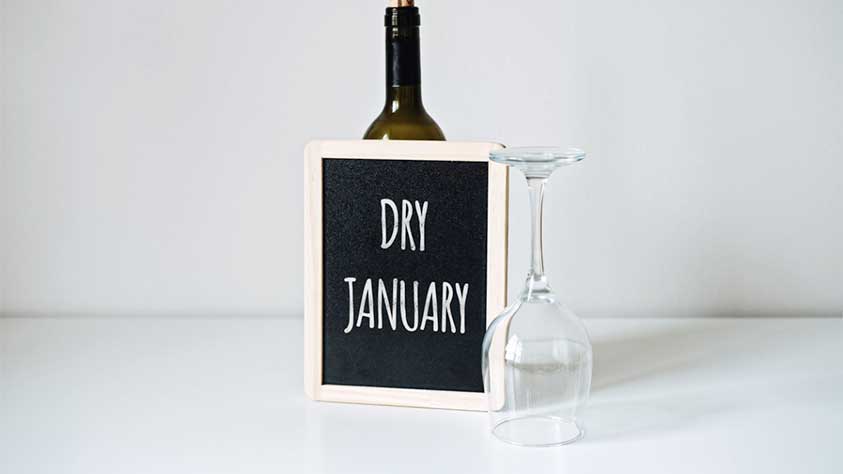5 Tips For A Successful Dry January

Medically Reviewed By: Manish Mishra, MBBS
A popular New Year’s resolution is to stop drinking altogether with a challenge called Dry January. To help those participating, we recommend making a plan, setting specific goals, and building a support system.

Dry January is an annual program that challenges people to abstain from alcohol for the first month of the New Year. It was first started in 2012 by Alcohol Change UK but has quickly spread worldwide, including to Ohio.
However, abstaining from drinking can be easier said than done, especially for someone with a history of alcohol abuse or alcohol addiction. Luckily, we have a few tips on how you can have a successful Dry January.
1. Know Your Reasons
The first step to take when deciding to do Dry January is to figure out the reason why you want to stop drinking. Make sure your reason is as specific as possible and not simply because drinking is “”bad.”
Maybe you don’t want to wake up with a hangover anymore or you want to improve a specific aspect of your health like your blood pressure.
Or maybe you want to improve your skin, have more energy, or improve your sleep. Whatever the reasons, make sure it’s clear to you what they are.
2. Make A Plan
After you figure out your reasons for participating in Dry January, it’s time to come up with a plan. How are you going to not drink during the whole month of January?
Build a plan that lists your goals, sets small milestones, and tracks your progress.
Whatever your plan is, make sure to write it down somewhere. Having a physical copy can provide accountability and give you something to look back to as you take this journey.
Beyond writing down your plan, you’ll also want to have a physical place where you track your progress. This can be in a journal, in an app, or in a spreadsheet on your computer.
Also, figure out what you’re going to do when things get hard. Will you talk to a friend, write in a journal, go for a walk or run, or leave a social function? Maybe finding some mocktails recipes can help you ensure you have a safe drink when you’re craving something.
3. Set Goals
Setting multiple small goals over the month can make the process a lot easier and more enjoyable than setting one big goal. You’re more likely to stay on track for the whole month with small attainable goals as well.
And, make sure those goals and milestones are realistic. You don’t want to make goals that are too hard to meet and then you feel discouraged when you fail to achieve them. Don’t set the bar too high. Be honest with yourself and then choose a goal from there.
Your goal can be to slowly reduce your number of drinks per week, stop buying alcohol, or avoid public places that serve alcohol. Whatever your goals may be, make sure they’re specific, measurable, achievable, relevant, and time-based.
4. Build A Support System
Dry January, or any addiction recovery goal, doesn’t have to be done alone. Have some friends join you this month or have your partner do it with you.
If nothing else, make sure to tell the people you care about what you’re doing. They can hold you accountable, keep you on track, and even distract you if you find yourself triggered or having a particularly difficult craving. Don’t be afraid to ask for help and support.
Your support system can also include support groups that are in person and online as well. There are tons of groups in Ohio, including Alcoholics Anonymous, that you can seek out to help you during the month.
Whether you have your family and friends or a group of supportive peers, doing Dry January with others can make you feel less alone.
5. Seek Professional Help
Dry January is not meant to be for those who already know they have an addiction and want to quit drinking. It is more for people who are looking to make a change or for those who want to see if they can stop drinking for a month.
That being said, if you realize your relationship with alcohol is much worse than you expected, looking for an addiction treatment center may be your next step.
Ohio has treatment options that can provide you with a customized plan that fits your specific needs. In Cleveland alone, there are over 50 different treatment centers to choose from.
You can start by talking to your primary healthcare provider, see what their advice is, and then go from there.
At our inpatient treatment center, we understand that treatment cannot be one size that fits all. We offer a wide-range of inpatient addiction treatment options including medical detox, behavioral therapy, and medication-assisted treatment.
For more information, please contact Ohio Recovery Center today.
- Alcohol Change UK — Dry January https://alcoholchange.org.uk/help-and-support/managing-your-drinking/dry-january
- SAMHSA — Find Treatment https://findtreatment.samhsa.gov/locator

